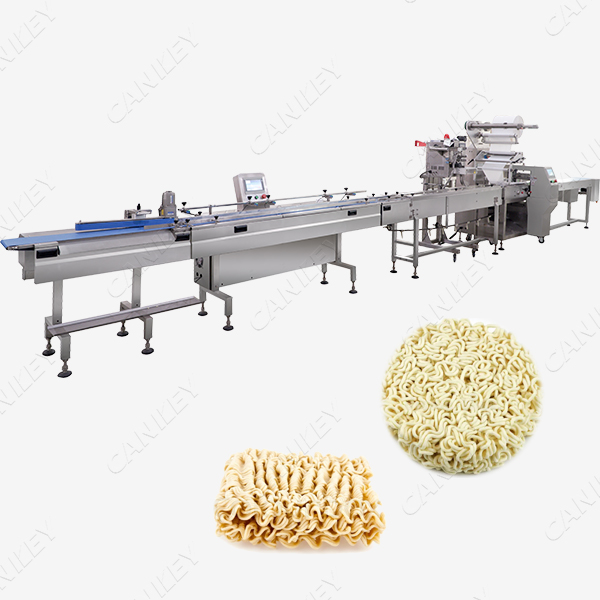The packaging process of instant noodles is a highly automated and efficient link in the production process of instant noodles. It is usually completed using a specialized instant noodle processing and packaging line. This article will introduce in detail how are instant noodles packed.
- Production of instant noodles
The production of instant noodles mainly includes the steps of mixing, rolling, cooking, cutting, frying or air-drying. First, wheat flour and water are mixed into a dough, and then the dough is pressed into thin sheets through a calender and then cut into thin strips. The noodles are steamed and shaped, and then fried or air-dried according to different product requirements, and finally the finished noodles are obtained.

2. Composition of instant noodle packaging line
The instant noodle packaging line is a comprehensive system that includes multiple equipment and steps, as follows:
A.Sorting machine
The sorting machine is responsible for arranging and transporting instant noodles in an orderly manner, usually through a conveyor belt to transport instant noodles from the production line to the packaging line. The main task of the sorting machine is to ensure that the instant noodles are in the correct position and direction before entering the packaging machine.
B.Packing Machine
The packaging machine is the core equipment of the instant noodle packaging line. Common packaging formats include bags and bowls. The packaging machine is responsible for placing instant noodles and seasoning packets into packaging containers and sealing them.
Bagged instant noodles: Instant noodles and seasoning packets are put into pre-made packaging bags through automated equipment, and then heat or cold sealed.
Bowl-packed instant noodles: Noodles and seasoning packets are put into pre-formed plastic or paper bowls, then covered with a waterproof film and sealed.
C.Testing Equipment
In order to ensure product quality, packaging lines are usually equipped with various detection equipment, such as metal detectors, weight detectors and X-ray machines. These devices can detect whether there are foreign objects inside the package, whether the weight meets standards, and whether the package is properly sealed.
D.Coding equipment
After packaging is completed, the product will pass through the coding equipment and be printed with production date, shelf life, batch number and other information. This information is very important for product traceability and management.
3. Advantages of automation
Improved efficiency: Automated equipment improves production and packaging efficiency and can process hundreds or even thousands of packages of instant noodles per minute.
Reduce labor costs: Automated equipment reduces dependence on labor, reducing labor costs and management difficulty.
Guarantee product quality: The precision and consistency of automated equipment ensure the stable quality of each package of instant noodles.
Improved safety: Through automatic detection and strict packaging processes, food contamination and packaging damage are effectively avoided.
The packaging process of instant noodles is complex and delicate. It relies on modern material sorting and packaging lines to achieve a high degree of automation and efficient production.
